Aquarium Glaser-GmbH
3 participants
Page 8 sur 8
Page 8 sur 8 •  1, 2, 3, 4, 5, 6, 7, 8
1, 2, 3, 4, 5, 6, 7, 8
 Poecilocharax weitzmani
Poecilocharax weitzmani
Poecilocharax weitzmani

Of course this fish is known in the hobby for decades already, but isn’t it nevertheless a breathtaking beauty? The tiny animal is an ideal companion of the cardinal tetra, along with which it occurs in the natural habitat, too.
Text & photo: Frank Schäfer.

Of course this fish is known in the hobby for decades already, but isn’t it nevertheless a breathtaking beauty? The tiny animal is an ideal companion of the cardinal tetra, along with which it occurs in the natural habitat, too.
Text & photo: Frank Schäfer.

blurami- admin
- Messages : 11164
Date d'inscription : 02/04/2010
Age : 44
Localisation : Aubergenville (78)
liste de maintenance
Mise à jour: 18/08/2015
 Hydrocynus goliath
Hydrocynus goliath
Hydrocynus goliath


Once more we received nice specimens of this gigantic predator from the Congo. For more information on the species, please see http://www.aquariumglaser.de/en/hydrocynus-goliath_de_1437.html

Text & photo: Frank Schäfer.


Once more we received nice specimens of this gigantic predator from the Congo. For more information on the species, please see http://www.aquariumglaser.de/en/hydrocynus-goliath_de_1437.html

Text & photo: Frank Schäfer.

blurami- admin
- Messages : 11164
Date d'inscription : 02/04/2010
Age : 44
Localisation : Aubergenville (78)
liste de maintenance
Mise à jour: 18/08/2015
 Apistogramma mendezi / Apistogramma paucisquamis
Apistogramma mendezi / Apistogramma paucisquamis
Apistogramma mendezi

Although Apistogramma mendezi can be imported only occasionally and is also rarely bred the beautiful species is known to develop a great number of local varieties. Additionally males of the very same local population show a high degree of polychromatism. The term polychromatism means that animals can show a differing individual colour pattern which leads to the observation that different colored animals can be found together.

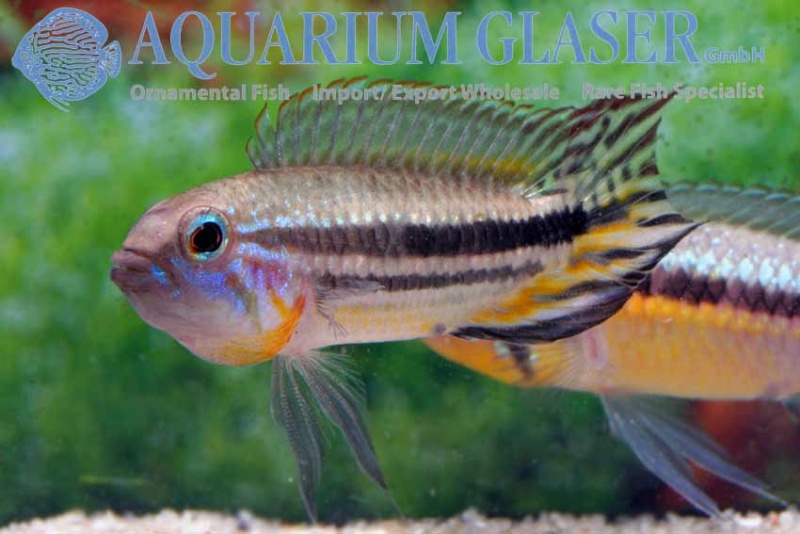
Currently we have a very attractive morph of A. mendezi in stock. The caudal fin of the fish has broad, longitudinal stripes in the lower part and round spots in the upper. Moreover the so called "belly stripe" below the lateral stripe is very distinctive in this population. It is very likely that this contrasting pattern is a result of the necessity that the females have to recognize the males of their own species. For our population of A. mendezi lives along with (= syntopically) the following, very similar species:
Apistogramma paucisquamis

This dwarf cichlid also lives in the dead leaves along the shores of blackwater streams as A. mendezi does. Usually these very similar species of Apistogramma live in geografically distinct areas. But it was suspected already for a long time that A. mendezi and A. paucisquamis could live syntopically in some regions eastern from Barcelos in the Rio Negro. Our specimes were imported mixed, so we think that they live together in the wild.
As in most cichlids, the females of Apistogramma choose the males and not the other way round. If similar species occur together, this leads usually to the fact that the males have to have a very distinct coloration, for otherwise the females cannot choose the correct males. In Apistogramma paucisquamis the males are characterized by the vertically striped caudal fin.
One might think the the fish do look very different, based on the pictures in this newsletter. But this misleads in so far, as the fish look very much alike when frightened or in neutral mood.
Like all Apistogramma species these two attractive dwarf cichlids need clean, germ-poor water and a bottom of fine sand . Hardness an pH are of lesser interest as long as the fish should be kept only, but for breeding attempts they need extremely soft and acidic water. Especially males of A. mendezi are quite gruff against the females, so the breeding tank should be rather large. Regarding food both species are undemanding and feed readily on any type of usual fish food, even dried ones.
Lexicon. Apistogramma: ancient Greek, means "with unreliable line". It is not known wether the lateral line organ or the pattern is meant. mendezi: dedication name for Chico Mendez, an eco-activist who fought against the destruction of the rainforest and was murdered by cattle barons in 1988. paucisquamis: Latin, means "with only few scales", which refers to the low number of scales around the caudal peduncle.
Text & Photos: Frank Schäfer.

Although Apistogramma mendezi can be imported only occasionally and is also rarely bred the beautiful species is known to develop a great number of local varieties. Additionally males of the very same local population show a high degree of polychromatism. The term polychromatism means that animals can show a differing individual colour pattern which leads to the observation that different colored animals can be found together.


Currently we have a very attractive morph of A. mendezi in stock. The caudal fin of the fish has broad, longitudinal stripes in the lower part and round spots in the upper. Moreover the so called "belly stripe" below the lateral stripe is very distinctive in this population. It is very likely that this contrasting pattern is a result of the necessity that the females have to recognize the males of their own species. For our population of A. mendezi lives along with (= syntopically) the following, very similar species:
Apistogramma paucisquamis

This dwarf cichlid also lives in the dead leaves along the shores of blackwater streams as A. mendezi does. Usually these very similar species of Apistogramma live in geografically distinct areas. But it was suspected already for a long time that A. mendezi and A. paucisquamis could live syntopically in some regions eastern from Barcelos in the Rio Negro. Our specimes were imported mixed, so we think that they live together in the wild.
As in most cichlids, the females of Apistogramma choose the males and not the other way round. If similar species occur together, this leads usually to the fact that the males have to have a very distinct coloration, for otherwise the females cannot choose the correct males. In Apistogramma paucisquamis the males are characterized by the vertically striped caudal fin.
One might think the the fish do look very different, based on the pictures in this newsletter. But this misleads in so far, as the fish look very much alike when frightened or in neutral mood.
Like all Apistogramma species these two attractive dwarf cichlids need clean, germ-poor water and a bottom of fine sand . Hardness an pH are of lesser interest as long as the fish should be kept only, but for breeding attempts they need extremely soft and acidic water. Especially males of A. mendezi are quite gruff against the females, so the breeding tank should be rather large. Regarding food both species are undemanding and feed readily on any type of usual fish food, even dried ones.
Lexicon. Apistogramma: ancient Greek, means "with unreliable line". It is not known wether the lateral line organ or the pattern is meant. mendezi: dedication name for Chico Mendez, an eco-activist who fought against the destruction of the rainforest and was murdered by cattle barons in 1988. paucisquamis: Latin, means "with only few scales", which refers to the low number of scales around the caudal peduncle.
Text & Photos: Frank Schäfer.

blurami- admin
- Messages : 11164
Date d'inscription : 02/04/2010
Age : 44
Localisation : Aubergenville (78)
liste de maintenance
Mise à jour: 18/08/2015
 Biotoecus dicentrarchus
Biotoecus dicentrarchus
Biotoecus dicentrarchus

Currently we can offer an absolute rarity from Venezuela: Biotoecus opercularis. In this dwarf cichlid the male attains a maximum length of about 6 cm, the female of about 4-5 cm. The fish are sandbottom dwellers. For breeding the male builds a large sandhill where the pair is spawning.

Text & photos: Frank Schäfer.

Currently we can offer an absolute rarity from Venezuela: Biotoecus opercularis. In this dwarf cichlid the male attains a maximum length of about 6 cm, the female of about 4-5 cm. The fish are sandbottom dwellers. For breeding the male builds a large sandhill where the pair is spawning.

Text & photos: Frank Schäfer.

blurami- admin
- Messages : 11164
Date d'inscription : 02/04/2010
Age : 44
Localisation : Aubergenville (78)
liste de maintenance
Mise à jour: 18/08/2015
 Barbus partipentazona
Barbus partipentazona
Barbus partipentazona

Finally we received wild collected specimens of this pretty barb again. Maximum size, keeping etc. is exactly as in the well known tiger barb. Barbus partipentazona originates from the south of Thailand.

Text & photos: Frank Schäfer.

Finally we received wild collected specimens of this pretty barb again. Maximum size, keeping etc. is exactly as in the well known tiger barb. Barbus partipentazona originates from the south of Thailand.

Text & photos: Frank Schäfer.

blurami- admin
- Messages : 11164
Date d'inscription : 02/04/2010
Age : 44
Localisation : Aubergenville (78)
liste de maintenance
Mise à jour: 18/08/2015
 Crenicichla marmorata Lago Maracana
Crenicichla marmorata Lago Maracana
Crenicichla marmorata Lago Maracana

Lago Maracana is famous among aquarists for its beautiful discus. We now received for the first time ever two wonderful Crenicichla marmorata from that lake. The fish are currently 20-25 cm long.

Text & photos: Frank Schäfer.

Lago Maracana is famous among aquarists for its beautiful discus. We now received for the first time ever two wonderful Crenicichla marmorata from that lake. The fish are currently 20-25 cm long.

Text & photos: Frank Schäfer.

blurami- admin
- Messages : 11164
Date d'inscription : 02/04/2010
Age : 44
Localisation : Aubergenville (78)
liste de maintenance
Mise à jour: 18/08/2015
 Carinotetraodon borneensis
Carinotetraodon borneensis
Carinotetraodon borneensis

This pufferfish lives exclusively in pure freshwater on Borneo and is only very rarely imported. The maximum length is about 6 cm (males) and 4 cm (females). In the wild this fish lives in soft and acidic water!


Text & photos: Frank Schäfer.

This pufferfish lives exclusively in pure freshwater on Borneo and is only very rarely imported. The maximum length is about 6 cm (males) and 4 cm (females). In the wild this fish lives in soft and acidic water!


Text & photos: Frank Schäfer.

blurami- admin
- Messages : 11164
Date d'inscription : 02/04/2010
Age : 44
Localisation : Aubergenville (78)
liste de maintenance
Mise à jour: 18/08/2015
 Iguanodectes adujai
Iguanodectes adujai
Iguanodectes adujai

The lizard tetras of the genus Iguanodectes are in general very rare aquarium fish. Currently 8 species are accepted. The very slender fish attain a maximum length of about 7 cm and are peaceful schooling fish.

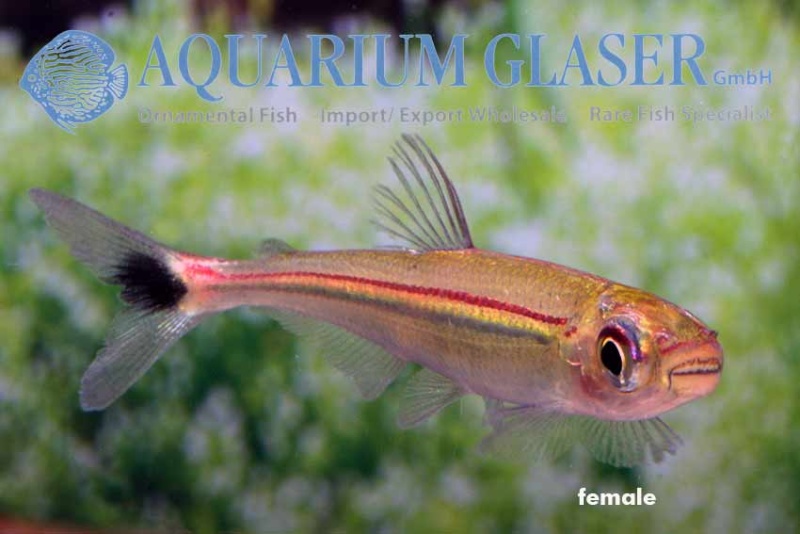
For the first time ever we could import the very pretty Iguanodectes adujai from Venezuela. This blackwater fish is characterized by the three coloured longitudinal bands on the flank. Males can be easily recognized by the red ventral, anal and caudal fins, which are transparent in females.
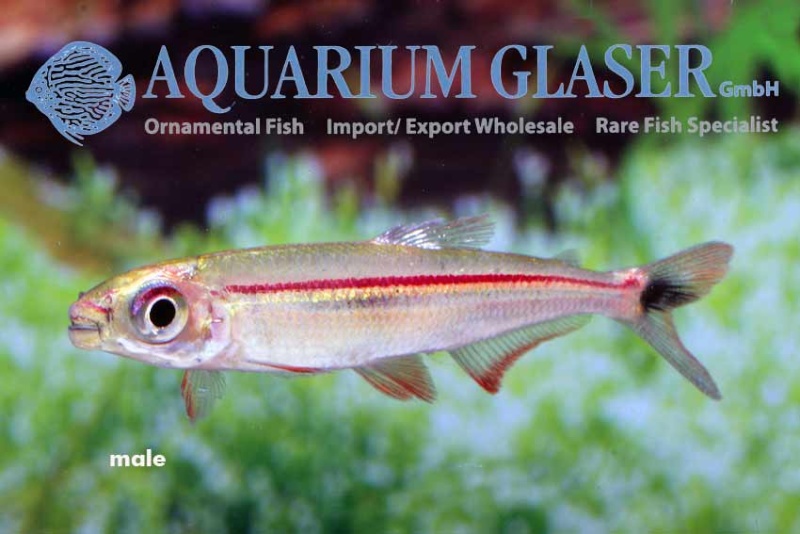
Lexicon: Iguanodectes: means "Iguana biter", referring to the teeth structure. adujai: after the type locality, the Rio Aduja.
Suggestion of a common name: Threebanded lizard tetra
Text & photos: Frank Schäfer.

The lizard tetras of the genus Iguanodectes are in general very rare aquarium fish. Currently 8 species are accepted. The very slender fish attain a maximum length of about 7 cm and are peaceful schooling fish.


For the first time ever we could import the very pretty Iguanodectes adujai from Venezuela. This blackwater fish is characterized by the three coloured longitudinal bands on the flank. Males can be easily recognized by the red ventral, anal and caudal fins, which are transparent in females.

Lexicon: Iguanodectes: means "Iguana biter", referring to the teeth structure. adujai: after the type locality, the Rio Aduja.
Suggestion of a common name: Threebanded lizard tetra
Text & photos: Frank Schäfer.

blurami- admin
- Messages : 11164
Date d'inscription : 02/04/2010
Age : 44
Localisation : Aubergenville (78)
liste de maintenance
Mise à jour: 18/08/2015
 Corydoras aeneus "Puerto Maldonado"
Corydoras aeneus "Puerto Maldonado"
Corydoras aeneus "Puerto Maldonado"

We received this beautiful colour morph of the Bronze corydoras that exhibits a lot of orange colours from Peru. It belongs to the "Gold Shoulder" group, which is sometimes named Corydoras schultzei; however, this name is currently considered to be a synonym of C. aeneus. The fish is very rare and available in limited numbers only!

Lexicon: Corydoras: from ancient Greek, means „with helmet and spear“. This refers to the strong armor and fin spines. aeneus: means "brazen, made of ore". schultzei: dedication name.
Common name: Gold shoulder corydoras
Text & photos: Frank Schäfer.

We received this beautiful colour morph of the Bronze corydoras that exhibits a lot of orange colours from Peru. It belongs to the "Gold Shoulder" group, which is sometimes named Corydoras schultzei; however, this name is currently considered to be a synonym of C. aeneus. The fish is very rare and available in limited numbers only!

Lexicon: Corydoras: from ancient Greek, means „with helmet and spear“. This refers to the strong armor and fin spines. aeneus: means "brazen, made of ore". schultzei: dedication name.
Common name: Gold shoulder corydoras
Text & photos: Frank Schäfer.

blurami- admin
- Messages : 11164
Date d'inscription : 02/04/2010
Age : 44
Localisation : Aubergenville (78)
liste de maintenance
Mise à jour: 18/08/2015
 Tucanoichthys tucano
Tucanoichthys tucano
Tucanoichthys tucano

Finally we are able to offer this tiny, very nice and extremely rare dwarf tetra once more. For more information please see http://www.aquariumglaser.de/en/archiv.php?news_id=178.
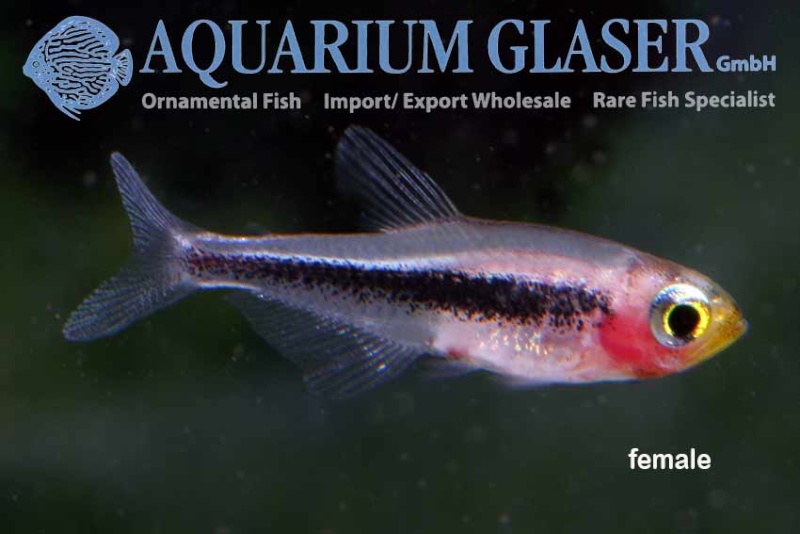
Text & photos: Frank Schäfer.

Finally we are able to offer this tiny, very nice and extremely rare dwarf tetra once more. For more information please see http://www.aquariumglaser.de/en/archiv.php?news_id=178.

Text & photos: Frank Schäfer.

blurami- admin
- Messages : 11164
Date d'inscription : 02/04/2010
Age : 44
Localisation : Aubergenville (78)
liste de maintenance
Mise à jour: 18/08/2015
 Biotoecus special!
Biotoecus special!
Biotoecus opercularis/dicentrarchus

For the first time ever we can offer both species of Biotoecus that have been described scientifically so far at the same time! Both species are among the rarest fish in the trade and this is the reason why it is so remarkable to have both of them in stock. Moreover, we can offer for the first time the population of Biotoecus opercularis from the Rio Curua.

Biotoecus for sure are not demanded due to their coloration. As typical sand cichlids they do not have pop-art colours, but shining pastel shades. The same phenomenon can be found in the sand dwelling cichlids from Lake Tanganyika. Nevertheless well adapted animals are really beautiful.
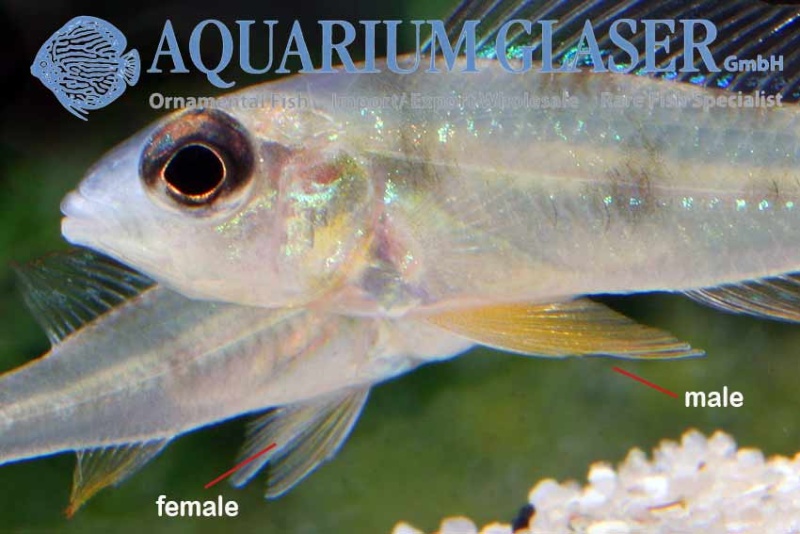
However, the aquarist’s interest in these fishes is not due to the attractive appearance of the fish, but due to their unique breeding behaviour. Every enthusiast should have once in a lifetime observed the male Biotoecus building up a hill from fine sand. Once this hill is erected, the male digs a pit and in this pit the fish spawn.

Biotoecus dicentrarchus originates from the Orinoco drainage in Venezuela. Our specimens are still comparably small, but as can be seen on the photos from our supplier they will become very nice when fully grown. B. dicentrarchus are even rarer in the trade than B. opercularis.
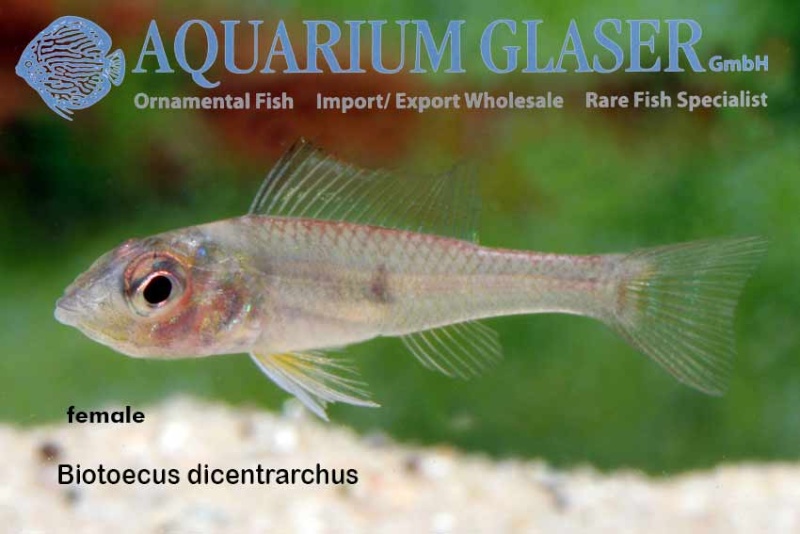
Regarding aquarium maintenance and breeding both species differ hardly. One should keep them in soft and acidic water at temperatures of around 24°C (slightly higher for breeding). The bottom in the tank must, however, be composed at least partially from sand. Biotoecus are very peaceful animals, even against small other species, and feed readily on any type of usual fishfood. Males and females can be best told apart by comparing the shape of the ventral fins (larger and more colorful in males). Moreover, females stay much smaller (3-4 cm) than males (5-6 cm).

For more informations and pictures of B. opercularis from the vicinity of Manaus, please see http://www.aquariumglaser.de/en/biotoecus-opercularis_de_1230.html
Lexicon: Biotoecus: ancient Greek, means "house of life". The authors of the genus believed Biotoecus to carry their young in their gills. opercularis: refers to the distinct black mark on the gill cover (Latin: operculum). dicentrarchus: ancient Greek, means "with two spines", referring to the anal fin, which has only two spines (compared with B. opercularis, which has three).
Suggestion of a common name: Sandhill dwarf cichlid
Text & photos: Frank Schäfer.

For the first time ever we can offer both species of Biotoecus that have been described scientifically so far at the same time! Both species are among the rarest fish in the trade and this is the reason why it is so remarkable to have both of them in stock. Moreover, we can offer for the first time the population of Biotoecus opercularis from the Rio Curua.

Biotoecus for sure are not demanded due to their coloration. As typical sand cichlids they do not have pop-art colours, but shining pastel shades. The same phenomenon can be found in the sand dwelling cichlids from Lake Tanganyika. Nevertheless well adapted animals are really beautiful.

However, the aquarist’s interest in these fishes is not due to the attractive appearance of the fish, but due to their unique breeding behaviour. Every enthusiast should have once in a lifetime observed the male Biotoecus building up a hill from fine sand. Once this hill is erected, the male digs a pit and in this pit the fish spawn.

Biotoecus dicentrarchus originates from the Orinoco drainage in Venezuela. Our specimens are still comparably small, but as can be seen on the photos from our supplier they will become very nice when fully grown. B. dicentrarchus are even rarer in the trade than B. opercularis.

Regarding aquarium maintenance and breeding both species differ hardly. One should keep them in soft and acidic water at temperatures of around 24°C (slightly higher for breeding). The bottom in the tank must, however, be composed at least partially from sand. Biotoecus are very peaceful animals, even against small other species, and feed readily on any type of usual fishfood. Males and females can be best told apart by comparing the shape of the ventral fins (larger and more colorful in males). Moreover, females stay much smaller (3-4 cm) than males (5-6 cm).

For more informations and pictures of B. opercularis from the vicinity of Manaus, please see http://www.aquariumglaser.de/en/biotoecus-opercularis_de_1230.html
Lexicon: Biotoecus: ancient Greek, means "house of life". The authors of the genus believed Biotoecus to carry their young in their gills. opercularis: refers to the distinct black mark on the gill cover (Latin: operculum). dicentrarchus: ancient Greek, means "with two spines", referring to the anal fin, which has only two spines (compared with B. opercularis, which has three).
Suggestion of a common name: Sandhill dwarf cichlid
Text & photos: Frank Schäfer.

blurami- admin
- Messages : 11164
Date d'inscription : 02/04/2010
Age : 44
Localisation : Aubergenville (78)
liste de maintenance
Mise à jour: 18/08/2015
 Cardisoma armatum
Cardisoma armatum
Cardisoma armatum
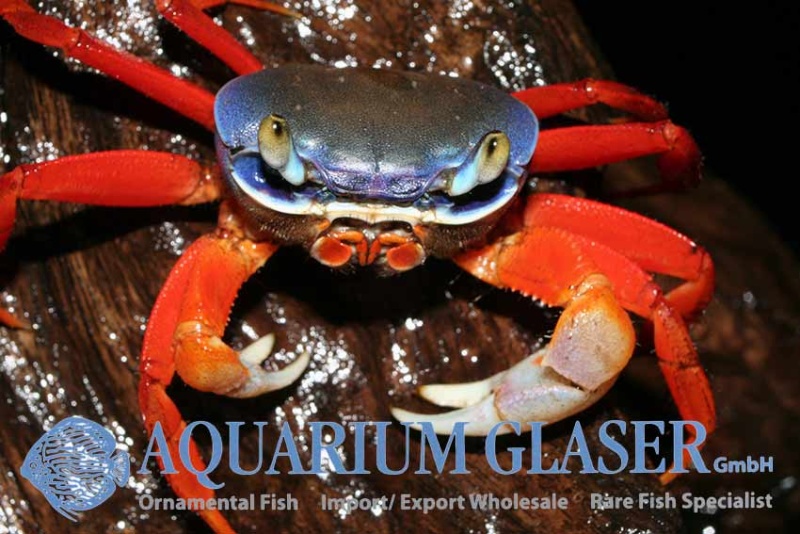
From the coasts of West and Central Africa originates Cardisoma armatum. The bright orange colored legs form a strong contrast to the blue body and let this crab become an attractive ornament. With a carapax diameter of approximately 10 cm it does not belong to the smallest crabs, therefore a spacy tank has to be offered for it. This species predominantly lives on land and needs only a small water-part in the aqua-terrarium. But one should keep in mind that these landcrabs breath through gills and the water - preferably slightly brackish water containing about 5-10 grams salt per litre water - in the gill-chamber must be renewed quite often. This is the reason why the water in the water-part of the aqua-terrarium must be always of top quality. These omnivorous crabs do not have high requirements on their food, they feed on a great variety of food, but fruits and vegetables form a large part of their diet.
Photo F. Schäfer, Text K. Diehl.

From the coasts of West and Central Africa originates Cardisoma armatum. The bright orange colored legs form a strong contrast to the blue body and let this crab become an attractive ornament. With a carapax diameter of approximately 10 cm it does not belong to the smallest crabs, therefore a spacy tank has to be offered for it. This species predominantly lives on land and needs only a small water-part in the aqua-terrarium. But one should keep in mind that these landcrabs breath through gills and the water - preferably slightly brackish water containing about 5-10 grams salt per litre water - in the gill-chamber must be renewed quite often. This is the reason why the water in the water-part of the aqua-terrarium must be always of top quality. These omnivorous crabs do not have high requirements on their food, they feed on a great variety of food, but fruits and vegetables form a large part of their diet.
Photo F. Schäfer, Text K. Diehl.

blurami- admin
- Messages : 11164
Date d'inscription : 02/04/2010
Age : 44
Localisation : Aubergenville (78)
liste de maintenance
Mise à jour: 18/08/2015
 Perisesarma huzardi
Perisesarma huzardi
Perisesarma huzardi

This crab is something like the big sister of the "classical" Red Mangrove Crab, Pseudosesarma moeschi. Regarding keeping that crab no major differences exist to that of the smaller relative with the exception that P. huzardi becomes as twice as large - about 8 cm carapax width. So the species needs bigger and more spacious tanks.
This Perisesarma species is completely euryhalin, which means that pure seawater can be used as well as pure freshwater; however it has proofed to be best to use brackish water (5 to 10 grams seasalt per litre), because nitrate and nitrite are by far less toxic in salty water than in pure freshwater.
One should feed these crabs which have the same job in the mangrove as the earthworms have in the garden, e.g. converting the dead leaves from the trees into humus, with dead leaves, fruits and vegetables. Besides this, one can feed any type of frozen fish food (not too much) and flakes. One should be very careful with protein rich granulates. The crabs like it, but they don´t stomach it very well.
Text & photo: Frank Schäfer.

This crab is something like the big sister of the "classical" Red Mangrove Crab, Pseudosesarma moeschi. Regarding keeping that crab no major differences exist to that of the smaller relative with the exception that P. huzardi becomes as twice as large - about 8 cm carapax width. So the species needs bigger and more spacious tanks.
This Perisesarma species is completely euryhalin, which means that pure seawater can be used as well as pure freshwater; however it has proofed to be best to use brackish water (5 to 10 grams seasalt per litre), because nitrate and nitrite are by far less toxic in salty water than in pure freshwater.
One should feed these crabs which have the same job in the mangrove as the earthworms have in the garden, e.g. converting the dead leaves from the trees into humus, with dead leaves, fruits and vegetables. Besides this, one can feed any type of frozen fish food (not too much) and flakes. One should be very careful with protein rich granulates. The crabs like it, but they don´t stomach it very well.
Text & photo: Frank Schäfer.

blurami- admin
- Messages : 11164
Date d'inscription : 02/04/2010
Age : 44
Localisation : Aubergenville (78)
liste de maintenance
Mise à jour: 18/08/2015
 Clibanarius africanus
Clibanarius africanus
Clibanarius africanus

The charming hermit crab Clibanarius africanus has become a very popular aquarium inhabitant. It is an euryhalin species, which means that it can survive in both pure fresh and pure marine water. However, it seems that it can live in pure freshwater only for a few months, so it is much better to keep it in brackish water. Clibanarius are detritus feeders. Detritus is composed from several dead stuff of plants and animals. In the aquarium, Clibanarius feed readily on any typical fish food. Usually C. africanus are imported with the brown snail shells of the snail species Tympanotonus fuscatus, but occasionally they bear the white houses of the snail Pachymelania aurita.
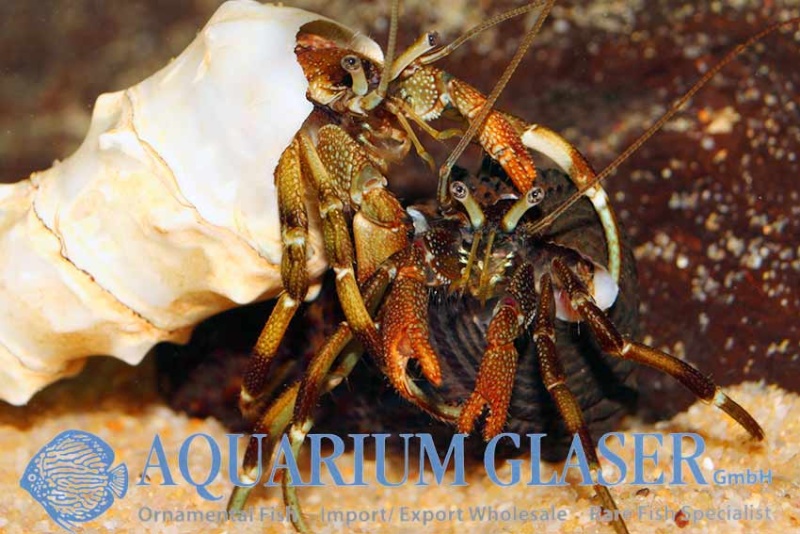
For more information on the hermit crab, please click http://www.aqualog.de/Aqualog/news/web69/69-17-19e.pdf
Lexicon: Clibanarius: term for a heavily armoured cavalryman. africanus: means "comes from Africa".
Text & photos: Frank Schäfer.

The charming hermit crab Clibanarius africanus has become a very popular aquarium inhabitant. It is an euryhalin species, which means that it can survive in both pure fresh and pure marine water. However, it seems that it can live in pure freshwater only for a few months, so it is much better to keep it in brackish water. Clibanarius are detritus feeders. Detritus is composed from several dead stuff of plants and animals. In the aquarium, Clibanarius feed readily on any typical fish food. Usually C. africanus are imported with the brown snail shells of the snail species Tympanotonus fuscatus, but occasionally they bear the white houses of the snail Pachymelania aurita.

For more information on the hermit crab, please click http://www.aqualog.de/Aqualog/news/web69/69-17-19e.pdf
Lexicon: Clibanarius: term for a heavily armoured cavalryman. africanus: means "comes from Africa".
Text & photos: Frank Schäfer.

blurami- admin
- Messages : 11164
Date d'inscription : 02/04/2010
Age : 44
Localisation : Aubergenville (78)
liste de maintenance
Mise à jour: 18/08/2015
 Pseudomugil pellucidus
Pseudomugil pellucidus
Pseudomugil pellucidus

For the first time ever we can offer this rare blue eye. The completely peaceful fish - they attain a maximum length of about 4 cm - a very interesting due to the fact that the stripe in the anal fin differs individually from yellow to red.
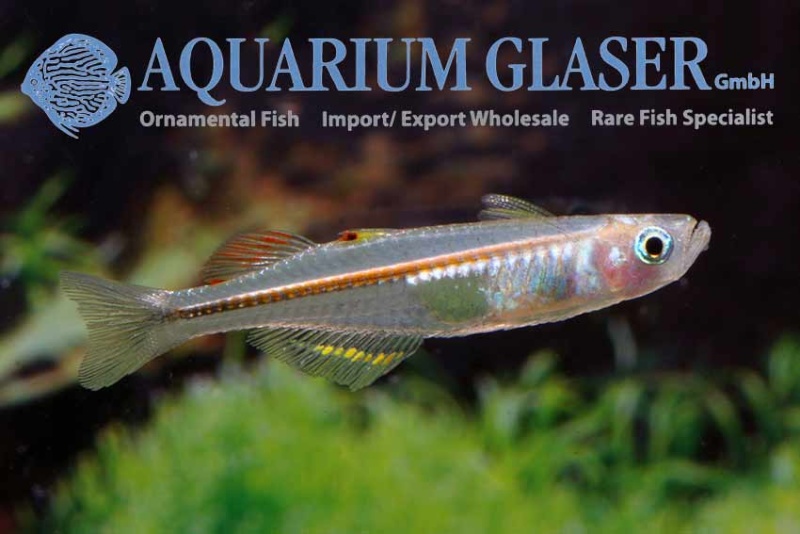

Text & photos: Frank Schäfer.

For the first time ever we can offer this rare blue eye. The completely peaceful fish - they attain a maximum length of about 4 cm - a very interesting due to the fact that the stripe in the anal fin differs individually from yellow to red.


Text & photos: Frank Schäfer.

blurami- admin
- Messages : 11164
Date d'inscription : 02/04/2010
Age : 44
Localisation : Aubergenville (78)
liste de maintenance
Mise à jour: 18/08/2015
 Moenkhausia costae
Moenkhausia costae
Moenkhausia costae

This tetra originates from Brazil (Rio Sao Francisco and Itapicuru). It reaches a maximum length of about 7 cm. Currently we can offer German bred specimens of this attractive schooling fish.
Text & photo: Frank Schäfer.

This tetra originates from Brazil (Rio Sao Francisco and Itapicuru). It reaches a maximum length of about 7 cm. Currently we can offer German bred specimens of this attractive schooling fish.
Text & photo: Frank Schäfer.

blurami- admin
- Messages : 11164
Date d'inscription : 02/04/2010
Age : 44
Localisation : Aubergenville (78)
liste de maintenance
Mise à jour: 18/08/2015
 Pterophyllum scalare Santa Isabel
Pterophyllum scalare Santa Isabel
Fantastic Pterophyllum scalare Santa Isabel arrived!

Yesterday reached us wonderful wild collected angels from Santa Isabel. The picture has been taken from one of the fish that arrived yesterday! The fish have a beautiful coloration and are in a perfect condition.
For more information see http://www.aquariumglaser.de/en/pterophyllum-scalare-santa-isabel_de_1487.html
Text & photo: Frank Schäfer.

Yesterday reached us wonderful wild collected angels from Santa Isabel. The picture has been taken from one of the fish that arrived yesterday! The fish have a beautiful coloration and are in a perfect condition.
For more information see http://www.aquariumglaser.de/en/pterophyllum-scalare-santa-isabel_de_1487.html
Text & photo: Frank Schäfer.

blurami- admin
- Messages : 11164
Date d'inscription : 02/04/2010
Age : 44
Localisation : Aubergenville (78)
liste de maintenance
Mise à jour: 18/08/2015
 Moenkhausia agnesae
Moenkhausia agnesae
Moenkhausia agnesae

We received this wonderful tetra from Peru. Moenkhausia agnesae is only very rarely available. The species attains a maximum length of about 8 cm. One should keep this tetra, which is sometimes a bit quarrelsome, along with other medium sized tetras, cichlids etc..
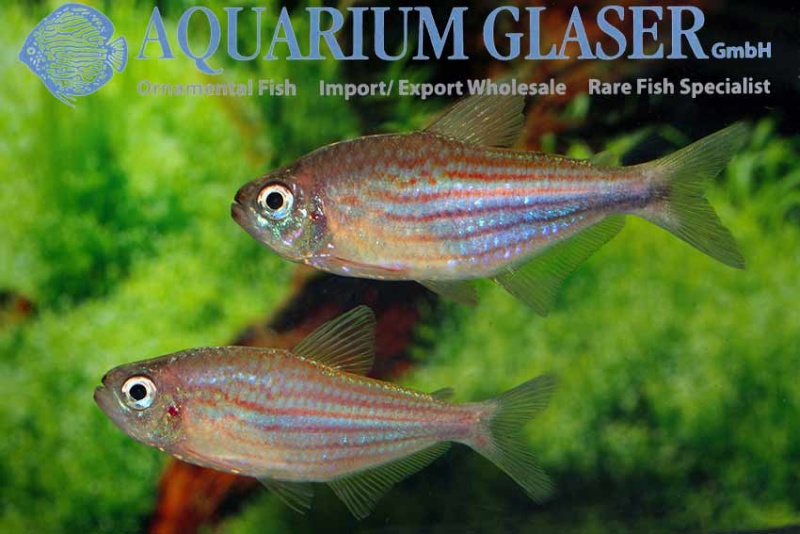
Our imported fish have almost show size and show breathtaking colours.
Text & photos: Frank Schäfer.

We received this wonderful tetra from Peru. Moenkhausia agnesae is only very rarely available. The species attains a maximum length of about 8 cm. One should keep this tetra, which is sometimes a bit quarrelsome, along with other medium sized tetras, cichlids etc..

Our imported fish have almost show size and show breathtaking colours.
Text & photos: Frank Schäfer.

blurami- admin
- Messages : 11164
Date d'inscription : 02/04/2010
Age : 44
Localisation : Aubergenville (78)
liste de maintenance
Mise à jour: 18/08/2015
 Tetranematichthys wallacei
Tetranematichthys wallacei
Tetranematichthys wallacei

Currently three different species of the remarkable genus Tetranematichthys are distinguished by scientists. None of them is often imported, because their secretive way of life between dead driftwood makes catching them a pure matter of luck. So we are very glad to have managed the first imporation ever of the species Tetranematichthys wallacei from Venezuela. We obtained three specimens and we are even more glad that they proofed to be one male and two females.
Like in the closely related genus Ageinosus the males of Tetranematichthys develope during the breeding season enormous dorsal fins. The spine of that fin is very thorny. The males attached with that thorny spine on the female during mating. The fertalisation is internal and managed by a penis-like organ that is formed by modified rays of the anal fin. It is said that after the breeding season the the dorsal fin in males reduces the size to that of the female.

This highly interesting and rare catfish reach a maximum total length of about 20 cm. It is carnivorous and prefers to feed on small fish. A tank for Tetranematichthys should contain fine sand on the bottom, should be softly lit and should be equipped with a great number of driftwood. During daytime the fish often sleep lying on the side. This behaviour is absolutely normal and no reason for the tank keeper to become anxious. Against conspecifics Tetranematichthys are completely peaceful.
Lexicon: Tetranematichthys: means "fish with four threats"; this refers to the barbels. wallacei: dedication name for Alfred Russel Wallace (1823-1913).
Suggestion of a common name: Wallace´s Driftwood Dolphin Catfish
Text & photos: Frank Schäfer.

Currently three different species of the remarkable genus Tetranematichthys are distinguished by scientists. None of them is often imported, because their secretive way of life between dead driftwood makes catching them a pure matter of luck. So we are very glad to have managed the first imporation ever of the species Tetranematichthys wallacei from Venezuela. We obtained three specimens and we are even more glad that they proofed to be one male and two females.
Like in the closely related genus Ageinosus the males of Tetranematichthys develope during the breeding season enormous dorsal fins. The spine of that fin is very thorny. The males attached with that thorny spine on the female during mating. The fertalisation is internal and managed by a penis-like organ that is formed by modified rays of the anal fin. It is said that after the breeding season the the dorsal fin in males reduces the size to that of the female.

This highly interesting and rare catfish reach a maximum total length of about 20 cm. It is carnivorous and prefers to feed on small fish. A tank for Tetranematichthys should contain fine sand on the bottom, should be softly lit and should be equipped with a great number of driftwood. During daytime the fish often sleep lying on the side. This behaviour is absolutely normal and no reason for the tank keeper to become anxious. Against conspecifics Tetranematichthys are completely peaceful.
Lexicon: Tetranematichthys: means "fish with four threats"; this refers to the barbels. wallacei: dedication name for Alfred Russel Wallace (1823-1913).
Suggestion of a common name: Wallace´s Driftwood Dolphin Catfish
Text & photos: Frank Schäfer.

blurami- admin
- Messages : 11164
Date d'inscription : 02/04/2010
Age : 44
Localisation : Aubergenville (78)
liste de maintenance
Mise à jour: 18/08/2015
 Gymnogeophagus caaguazuensis
Gymnogeophagus caaguazuensis
Gymnogeophagus caaguazuensis

We received wonderful wild collected specimens of this mouthbrooding cichlid (the females orally broods the larvae and young fry) from Paraguay. This species attains a maximum length of about 9 cm only (standard length, with the caudal fin the maximum length is around 12 cm) and thus is one of the smallest members of the genus. We have three sizes in stock: 4-6 cm (just reaching maturity), 8-10 cm (adult) and 10-12 cm (show size).

Text & photos: Frank Schäfer.

We received wonderful wild collected specimens of this mouthbrooding cichlid (the females orally broods the larvae and young fry) from Paraguay. This species attains a maximum length of about 9 cm only (standard length, with the caudal fin the maximum length is around 12 cm) and thus is one of the smallest members of the genus. We have three sizes in stock: 4-6 cm (just reaching maturity), 8-10 cm (adult) and 10-12 cm (show size).

Text & photos: Frank Schäfer.

blurami- admin
- Messages : 11164
Date d'inscription : 02/04/2010
Age : 44
Localisation : Aubergenville (78)
liste de maintenance
Mise à jour: 18/08/2015
 Rhinogobius zhoui
Rhinogobius zhoui
Rhinogobius zhoui, flame goby

This freshwater goby, which attains a maximum length of 4-5 cm, is one of the most attractive discoveries of ornamental fish of the last years. However, in the beginning the fish were extremely expensive. Currently we can offer them for the first time for a comparably moderate price.


Rhinogobius zhoui originates from China. In the natural habitat - brooks - it lives along with the well known goby Rhinogobius duospilus (often better known under the synonymous name R. wui) and other species. R. zhoui is a pure freshwater goby. One should keep them in unheated aquaria (16-22°C) due to the subtropical region the fish come from. The water should be clean and have some current. Keeping and feeding the fish is otherwise unproblematic.


Males are distinguished from the females by the broad white seams in the fins and the more intensive colours. The small fish change their coloration quite often and quick. It is a lot of fun to observe an aquarium that contains these tiny gobies that are always in the mood for a harmless quarrel.
Text & photos: Frank Schäfer.

This freshwater goby, which attains a maximum length of 4-5 cm, is one of the most attractive discoveries of ornamental fish of the last years. However, in the beginning the fish were extremely expensive. Currently we can offer them for the first time for a comparably moderate price.


Rhinogobius zhoui originates from China. In the natural habitat - brooks - it lives along with the well known goby Rhinogobius duospilus (often better known under the synonymous name R. wui) and other species. R. zhoui is a pure freshwater goby. One should keep them in unheated aquaria (16-22°C) due to the subtropical region the fish come from. The water should be clean and have some current. Keeping and feeding the fish is otherwise unproblematic.


Males are distinguished from the females by the broad white seams in the fins and the more intensive colours. The small fish change their coloration quite often and quick. It is a lot of fun to observe an aquarium that contains these tiny gobies that are always in the mood for a harmless quarrel.
Text & photos: Frank Schäfer.

blurami- admin
- Messages : 11164
Date d'inscription : 02/04/2010
Age : 44
Localisation : Aubergenville (78)
liste de maintenance
Mise à jour: 18/08/2015
 Geophagus harreri
Geophagus harreri
Geophagus harreri

For the first time ever we can offer this pretty eartheater. The parents originate from Suriname (exactly: the Tapanahoni river. However, the species occurs also in other rivers of Suriname, like the Maroni river, for example). The fish prefer a moderate to strong current, but change to habitats with less current for breeding. Keeping conditions: this species needs comparably high water temperatures and should be kept at least at 28°C. It is no problem at all to high up to 32°C! Soft, acidic and bacteria poor water boost coloration and set the fish up in general.
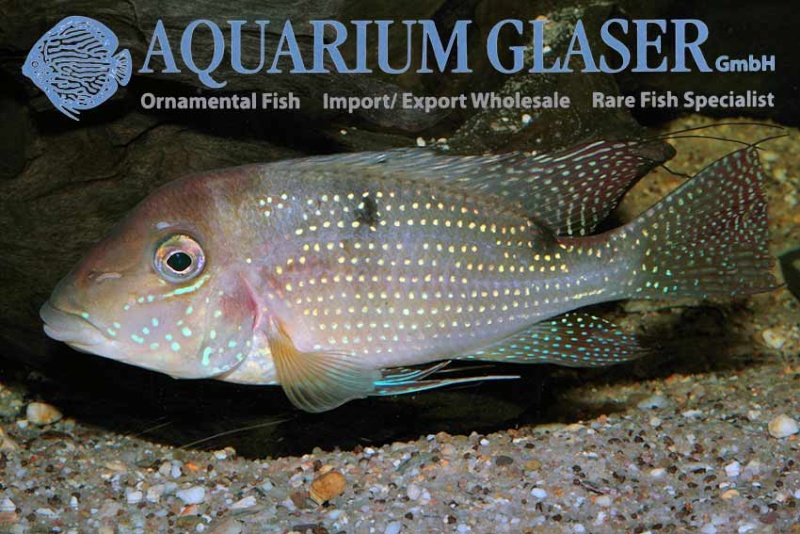

Maximum size: probably around 25 cm. Males become larger and are more elongate. Females stay smaller and look more stout. Old fish may get a slight hump, but this seems not to be sex-specific.


The species belongs to the open brooders and use roots or stones for spawning. Compared with other eartheaters, this species can be very aggressive. Thus one should keep G. harreri only in very spacious tanks (200 cm minimum length). It is possible to keep the species along with other large cichlids (other eartheaters, Mesonauta, Heros, Uaru, etc.) and keeping G. harreri in company with many other fish calms them down in respect to the aggressiveness. Personally I had until now up to 150 fry, but I guess that a good pair can produce around 400 young.

Text & Photos: Thomas Weidner
Lexicon: Geophagus: means "eartheater". harreri: dedication name for one of the collectors of the type material.
Suggestion of a common name: Marowijne eartheater

For the first time ever we can offer this pretty eartheater. The parents originate from Suriname (exactly: the Tapanahoni river. However, the species occurs also in other rivers of Suriname, like the Maroni river, for example). The fish prefer a moderate to strong current, but change to habitats with less current for breeding. Keeping conditions: this species needs comparably high water temperatures and should be kept at least at 28°C. It is no problem at all to high up to 32°C! Soft, acidic and bacteria poor water boost coloration and set the fish up in general.


Maximum size: probably around 25 cm. Males become larger and are more elongate. Females stay smaller and look more stout. Old fish may get a slight hump, but this seems not to be sex-specific.


The species belongs to the open brooders and use roots or stones for spawning. Compared with other eartheaters, this species can be very aggressive. Thus one should keep G. harreri only in very spacious tanks (200 cm minimum length). It is possible to keep the species along with other large cichlids (other eartheaters, Mesonauta, Heros, Uaru, etc.) and keeping G. harreri in company with many other fish calms them down in respect to the aggressiveness. Personally I had until now up to 150 fry, but I guess that a good pair can produce around 400 young.

Text & Photos: Thomas Weidner
Lexicon: Geophagus: means "eartheater". harreri: dedication name for one of the collectors of the type material.
Suggestion of a common name: Marowijne eartheater

blurami- admin
- Messages : 11164
Date d'inscription : 02/04/2010
Age : 44
Localisation : Aubergenville (78)
liste de maintenance
Mise à jour: 18/08/2015
 Synodontis nigriventris
Synodontis nigriventris
Synodontis nigriventris - finally available again!

This species represents without any doubt the most popular African catfish at all. The Upside Down Cat (Synodontis nigriventris) has reached us in good numbers and a perfect size again. Currently the fish are 3-4 cm long.

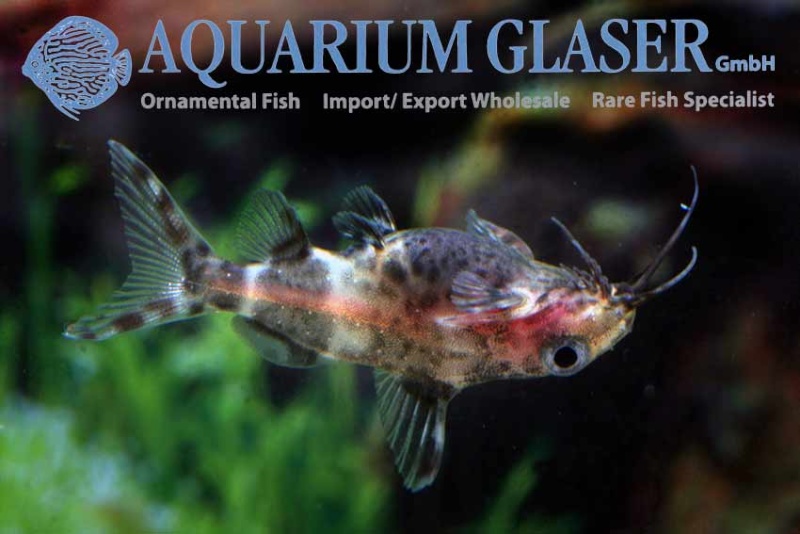
Text & photos: Frank Schäfer.

This species represents without any doubt the most popular African catfish at all. The Upside Down Cat (Synodontis nigriventris) has reached us in good numbers and a perfect size again. Currently the fish are 3-4 cm long.


Text & photos: Frank Schäfer.

blurami- admin
- Messages : 11164
Date d'inscription : 02/04/2010
Age : 44
Localisation : Aubergenville (78)
liste de maintenance
Mise à jour: 18/08/2015
Page 8 sur 8 •  1, 2, 3, 4, 5, 6, 7, 8
1, 2, 3, 4, 5, 6, 7, 8
 Sujets similaires
Sujets similaires» pb aquarium 90l
» Mon 1er aquarium
» Aquarium Rsm 130
» APN et aquarium ...
» Le mode "Aquarium" de mon APN
» Mon 1er aquarium
» Aquarium Rsm 130
» APN et aquarium ...
» Le mode "Aquarium" de mon APN
Page 8 sur 8
Permission de ce forum:
Vous ne pouvez pas répondre aux sujets dans ce forum|
|
|



